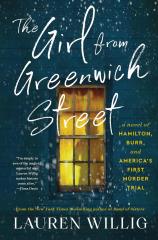The Girl from Greenwich Street: A Novel of Hamilton, Burr, and America's First Murder Trial
Review
The Girl from Greenwich Street: A Novel of Hamilton, Burr, and America's First Murder Trial
Lauren Willig's historical fiction is always meticulously researched. If she seems to demonstrate a superpower, it's her ability to draw readers in through her characters. Her novels make reading --- and learning about history --- extremely enjoyable. In THE GIRL FROM GREENWICH STREET, Willig doesn't create her own characters, as the real-life figures are compelling enough for her to work with. She has created a wonderful murder mystery based on an actual trial in which Alexander Hamilton and his nemesis, Aaron Burr, were co-counsel.
The title character is Elma Sands. She was born out of wedlock, and Willig makes much of Burr's pejorative use of "bastard" when describing the girl in order to rile Hamilton, who also was born out of wedlock. Elma lives with her cousin, Caty; Caty's husband, Elias; Caty's sister, Hope; and many others in the boarding house that Caty runs. We know from the prologue that Elma is planning to be married and get away from the house where Caty is cold to her; she is treated like the poor relation that she is.
But instead of marriage, Elma ends up murdered, her body dumped in the Manhattan Well. While introducing us to the characters, Willig paints a picture of post-colonial New York. As she describes the area on Greenwich Street in detail, I found myself wishing for a map so I could more clearly visualize the spaces around the murder site. The villain is assumed to be Levi Weeks, the brother of a successful carpenter, who boarded in the house. He was a very friendly, handsome and charming young man and was close friends with Elma. We find out that when she was sick, he cared for her and didn't leave her side.
"We become immersed in the story of the individuals whose lives were thrown into turmoil by Elma's death.... [A]t no time is the narrative stolid; the events move quickly, with actual quotes from that time prefacing each chapter. This is historical fiction at its best."
So it's understandable that when Elma tells Hope that she's going to be married, Hope concludes that it must be Levi who is her intended, thus dashing Hope's feelings toward Levi. But as we come to find out, there's a lot more happening than one might guess. As the attorneys on both sides question witnesses about the happenings on the day of Elma's death and the weeks preceding it, facts are revealed that muddy the waters.
One of the benefits of reading historical fiction is the knowledge we acquire from the actual past. Here we learn about the origin of the word "lynch" as Willig writes about Lynch law: "Charles Lynch and the men like him who took it upon themselves to enact vengeance on those they’d condemned without process of law were anathema to everything Alexander stood for." Because of the furor over Elma’s death, and the manner in which Caty's husband keeps her body on display for all to witness, Hamilton worries about a lynching.
In this time before police departments, constables were tasked only with keeping the peace. Lawyers did their own investigations when their clients were charged with crimes, and that was true for both the prosecution and defense attorneys. Thus Willig makes us privy to what she imagines the investigation might have looked like as Cadwallader Colden, the assistant district attorney, and Hamilton, one of the defense lawyers, try to determine exactly what happened to Elma.
The interplay between Burr and Hamilton is fascinating, as is this glimpse into politics and life in those post-colonial times. We clearly see the results from the lack of a sewage system as the summer heat brings sickness, and those who are able to do so flee to the countryside.
What is also fascinating is the country we see through Willig's eyes, which in some ways is not unlike the America of today. It was a fractured nation, as we see in the closing statement that Hamilton wrote but was stolen by Burr --- at least according to Willig. The narrative states, "What was that but a veiled reference to the state of the country itself? A country fractured and fractious, in which Hamilton sought to position himself as the heir to General Washington, the man who could hold their fragile republic together in the face of forces seeking to break it apart."
In the historical note at the end, Willig mentions that Hamilton's reason for joining the defense team remains a mystery. Levi's brother, Ezra Weeks, retained Burr and Brockholst Livingston. She says, "Brockholst had a brilliant record as a criminal defense attorney." But Hamilton had little experience in criminal cases, and even less in murder cases. Willig offers theories about Hamilton's decision, and they make sense. She also shares her reasoning for the conclusions at which she arrived in writing about the trial, the murder, and the evidence she used in the story.
But even if you aren't interested in historical events, read THE GIRL FROM GREENWICH STREET because you'll come to like and respect Hope, who believes the gossip about Levi but is intelligent enough to change her mind when facts are shown to be different from what was first believed. Hope had been a bit in love with Levi and had hoped that feeling was reciprocal. We feel for Cadwallader, whose legal expertise and oratory are far inferior to those of his three opponents in the case. Hamilton's thoughts and feelings are shared in those chapters written from his point of view, just as Willig shares Burr's thoughts in chapters written from his perspective, both of which give us great insight into these two men.
We become immersed in the story of the individuals whose lives were thrown into turmoil by Elma's death. The amount of research Willig undertook to be able to meticulously detail the events and lives of the people in the novel is staggering. Yet at no time is the narrative stolid; the events move quickly, with actual quotes from that time prefacing each chapter. This is historical fiction at its best.
Reviewed by Pamela Kramer on March 14, 2025
The Girl from Greenwich Street: A Novel of Hamilton, Burr, and America's First Murder Trial
- Publication Date: March 4, 2025
- Genres: Fiction, Historical Fiction, Historical Mystery, Historical Thriller, Suspense, Thriller
- Hardcover: 352 pages
- Publisher: William Morrow
- ISBN-10: 0063306115
- ISBN-13: 9780063306110




